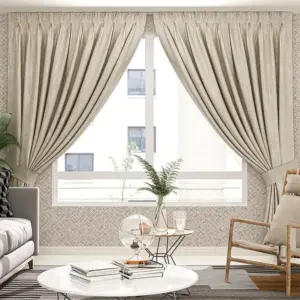Curtain Cleaning Tips for UAE Homes: From Desert Dust to Coastal Humidity

Why Curtain Maintenance Matters in the UAE
In the UAE, where interiors are subjected to a special combination of desert dust, coastal moisture, and strong sunlight, curtain maintenance is not a choice—it’s a necessity. Curtains are more than a decorative choice—they control light, guard privacy, insulate interiors, and hold airborne particles in. At HOC Furniture, we always think that caring for your curtains keeps them beautiful and functional, making your home always feel crisp, clean, and fashionable. Failure to do curtain maintenance will result in premature wear on fabrics, stinky odors, as well as compromised indoor air quality, particularly in the city.
Dust and Sand from the Desert
Desert breezes commonly blow fine sand into houses via windows, balconies, and even air conditioning vents. Curtains, particularly those with textured or heavier material, have a tendency to trap such dust, acting as a silent dust catch over time. Such buildup can not only dim the look of your curtains but also bring on allergies and respiratory issues. Regular dusting and vacuuming prevent such buildup, maintaining your curtains’ color vibrancy as well as your family’s health.
Humidity and Mold Risks in Coastal Areas
Coastal cities such as Abu Dhabi, Dubai, and Sharjah have a hot, humid environment that raises the possibility of mold and mildew, especially in air-conditioned residences where condensation occurs. This provides an ideal environment for mold spores to develop on textile surfaces. Mold can easily establish itself in curtain materials and cause annoying stains, unpleasant smells, and health risks for people with asthma or allergies. Daily cleaning and proper ventilation help avoid moisture accumulation and extend fabric life.
Sun Exposure and Fabric Fading
UAE residences have south-facing windows that receive intense sunlight all day long. Ongoing exposure softens fibers and promotes noticeable fading in light or deeply colored fabrics. Gradually, curtains lose their beauty and functionality. To mitigate this, use UV-filtering window films, shielded curtain linings, or blinds overlay. Investing in fade-resistance fabrics can also decrease visible deterioration in sunny environments to a great extent.
Air Quality and Allergens
Curtains are passive air filters, trapping allergens like dust mites, pollen, and pet dander. Curtains in households with allergy patients, not kept clean, increase the allergy symptoms, and living becomes unbearable. Air pollution is a rising issue in highly populated UAE cities, where traffic and construction emissions contribute to increasing pollution levels. Regular curtain care not only helps maintain the material but also helps in sustaining a healthier indoor environment, particularly when paired with air purifiers or better ventilation.
How Often Should You Clean Your Curtains?
Every cleaning method is not applicable for all types of fabric. Being aware of what can be washed at home and what needs to be done by a professional will prevent you from ruining your curtains permanently. There is a time for both DIY and professional cleaning, depending on the type of curtain, how badly soiled they are, and the type of equipment you have.
Machine Washing Curtains: What to Know
Machine wash is best for cotton, polyester, or synthetic blends of curtains, provided the label supports it. Use gentle detergents and cold water on a gentle wash mode. Avoid overfilling the machine and take out metal hooks or tiebacks first. Tumble drying should be avoided in favor of air drying to prevent shrinkage. Before the first wash, always test for colorfastness to prevent bleeding.
Hand Washing Delicate Curtains
Hand washing is more time-consuming but gentler for fragile materials such as lace, linen, or lightly treated blackout fabric. Use lukewarm water and a bleach-free, gentle detergent. Soak the fabric gently without scrubbing and wringing. Rinse well and lay flat to dry to prevent distortions in the fabric.
Dry Cleaning – When It’s Necessary
Silk, velvet, and the ones with elaborate embroidery should always be cleaned dry. Water can destroy the delicate fabric structure as well as the dyes used in these materials. Dry cleaning is also advisable for curtains that have deposited grease or heavy smoke particles. Always notify your cleaner if the curtains have backing or linings.
Steam Cleaning Curtains at Home
Steam cleaning is a good means of reviving curtains without taking them off their rods. It cleans effectively on thick materials such as velvet or cotton, and sanitizes, deodorizes, and smooths wrinkles. Employ a handheld steam cleaner and pretest a small area first. Hold the nozzle at a safe distance to prevent water spots.
Removing Stains and Odors Safely
For spot cleaning, dab the stain with a clean cloth and a mild cleaning solution. Never rub, which can ruin the fibers. Natural cleaning solutions such as diluted vinegar or baking soda solutions may also be used to neutralize odors. Always test in an inconspicuous area first, however.
Daily and Weekly Maintenance Tips
Regular maintenance is the simplest way to extend the life of your curtains. These daily and weekly habits help minimize dust, reduce wear, and delay the need for professional cleaning.
Dusting Curtains with a Vacuum or Lint Roller
Vacuum using an upholstery attachment or a hand vacuum cleaner to get rid of surface dust. Use a lint roller to remove hair and particles from lighter fabrics. Do it weekly, especially on high-traffic spaces.
Using Air Purifiers to Reduce Dirt Build-up
Air cleaners reduce airborne dust and pollution, hence less dirt on your curtains. They are particularly beneficial for homes located near construction sites or busy roads, where outside particles easily get inside.
Opening Windows Strategically to Minimize Dust Entry
While ventilation is essential, attempt to open windows in the early morning or late evening when winds are gentler and dust concentrations are low. Install fine mesh screens, if possible, to minimize the entry of dust.
Tiebacks and Curtain Accessories – Clean Them Too
Generally neglected, tiebacks and curtain rods may gather dust and moisture. Clean them once a week with a damp cloth. Spot clean or wash machine-enabled fabric tiebacks, depending on the fabric.

How to Prevent Fading and Fabric Damage
Maintaining your curtain’s color and durability demands preventative care, particularly in sunny and hot regions such as the UAE.
Use UV-Lining or Protective Backing
Installing a UV-protective lining on your curtains protects them from damaging rays and prolongs their lifespan. It also guards against damage to inner furnishings. All of our clients also choose the dual-layer arrangements with blinds, which may be controlled separately.
Rotate or Swap Out Curtains Seasonally
Rotating curtains every few months serves to distribute sunlight evenly, thereby minimizing localized fading. Retain one set for summer and another for winter for maximum curtain retention and mood boost by season.
Avoid Direct Sunlight When Possible
Utilize sheer curtains, blinds, or frosted films on windows facing strong sun light. Closing the curtains during the hottest time of day also minimizes fading and indoor heat gain.
Choose Fade-Resistant Fabrics for South-Facing Windows
Choose fade-resistant polyester or acrylic blends for sunlit rooms. They are better at maintaining color and easier to clean.
For further reading on the ways blinds can complement the use of curtains while providing extra protection and aesthetics, refer to our comprehensive Blinds Care Guide.
Curtain Ironing and Rehanging Tips
Curtains will get wrinkled when they are washed, so ironing or steaming them correctly afterward makes a big difference in appearance.
Iron or Steam While Slightly Damp
The simplest moment to iron out wrinkles is when curtains are fresh from the washer and remain moist. Employ a steam iron on the back side for natural materials or a garment steamer to remove wrinkles while the garment is on the hanger. Do not press too hard to avoid fabric shine.
Use Low Heat Settings on Delicates
Fine materials such as silk or lace need minimal heat to avoid burning. Iron always using a pressing cloth in between the curtain and the iron. Read labels and be cautious when ironing unfamiliar materials.
Rehanging for Even Draping After Wash
After steaming or ironing, rehang curtains warm to allow them to settle into natural, neat folds. Clip uniformly spaced panels or pleats so that there is even draping across the window.
Tips to Remove Wrinkles Without Ironing
Use a bathroom steam trick: hang your curtains in the bathroom while running a hot shower. The steam will soften creases over time. Alternatively, lightly mist curtains with water and smooth them out gently by hand.
Storing Curtains the Right Way
When storing curtains between seasons or during renovations, proper handling ensures they stay clean and wrinkle-free.
How to Fold and Store Without Creases
Flat lay curtains and loosely fold along pleat lines to prevent setting hard creases. Never tightly roll or stuff them into boxes. Add tissue paper between layers to cushion embroidery or fragile fabrics.
Use Silica Gel or Moisture Absorbers
Store silica gel packets or other moisture absorbers in storage boxes or wardrobes to discourage mold and mildew. This is particularly vital for humid climates or summer seasons.
Ideal Storage Temperature and Light Conditions
Store curtains in a dry, cool, dark environment to prevent fading and mildew. Don’t store near heaters or direct sunlight, which can break down fabrics even while in storage.
When to Replace Your Curtains
Even with regular maintenance, a time arrives when the best course of action is replacing them.
Signs of Wear and Tear
Look for thinning materials, frayed edges, or curtain rings being pulled out of alignment. If your curtains no longer hang as they should or look limp, then it might be time to renew your environment with a new set.
Permanent Stains or Shrinking
Stains that cannot be cleaned or curtains that have shrunk oddly in the wash may no longer be functional or aesthetically pleasing.
Outdated Styles or Renovation Needs
A recently refurbished room might require a contemporary touch. Altering your curtains is a budget-friendly means of updating interiors and your personal taste.
Where to Find Cleaning Services for Curtains in the UAE
Professional cleaning services are a great solution for busy homeowners or for sensitive materials that require special care.
Recommended Curtain Cleaning Companies (Dubai, Abu Dhabi, Sharjah)
Search for home textile cleaning companies with excellent customer reviews and a fair pricing system. HOC Furniture regularly works with established companies in Dubai, Abu Dhabi, and Sharjah for deep cleaning and maintenance.
Home Pickup & Delivery Services
Free pickup and delivery of curtains from homes is a common service offered by many cleaning companies in the UAE. It simplifies the process, especially for large spaces or heavy window treatments.
Cost Expectations for Professional Cleaning
Prices are different based on size and material, but you should pay anywhere from AED 15 to AED 40 per kg or per panel. Professional cleaning of silk or velvet can cost extra.
Should You Replace Curtains Instead of Cleaning?
If cleaning costs are getting close to or beyond the curtain’s value—particularly if there is damage or staining—replacing might be the more economical option. HOC Furniture provides custom curtain solutions to revitalize your surroundings with minimal inconvenience.
FAQs – Curtain Cleaning and Care in UAE
How often should I wash my curtains?
Typically, curtains should be vacuumed every week and washed every 3–6 months. Areas with more usage or where pets reside might require more frequent cleaning.
Can I machine wash blackout curtains?
Certain blackout curtains can be machine washed, but first, read the care label. Many contain a coated backing that deteriorates in machines.
What’s the best way to remove sand and dust from curtains?
Shake them out in a clean area outside or vacuum them with a handheld vacuum. Dusting regularly keeps sand from accumulating.
Should I dry clean velvet or silk curtains?
Yes, they are water-sensitive and must be treated by professionals.
Is steam cleaning effective for curtains in humid climates?
Yes, steam cleaning is effective but make sure your house is well-ventilated so that it will dry properly and not lead to mold.
Can curtains help with air quality in the UAE?
Yes. Curtains filter airborne particles and, when cleaned frequently, can contribute to better indoor air quality in conjunction with air purifiers.

